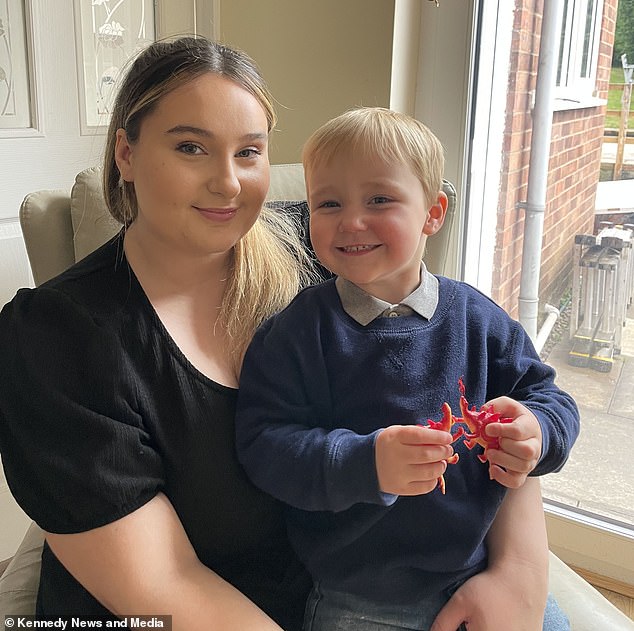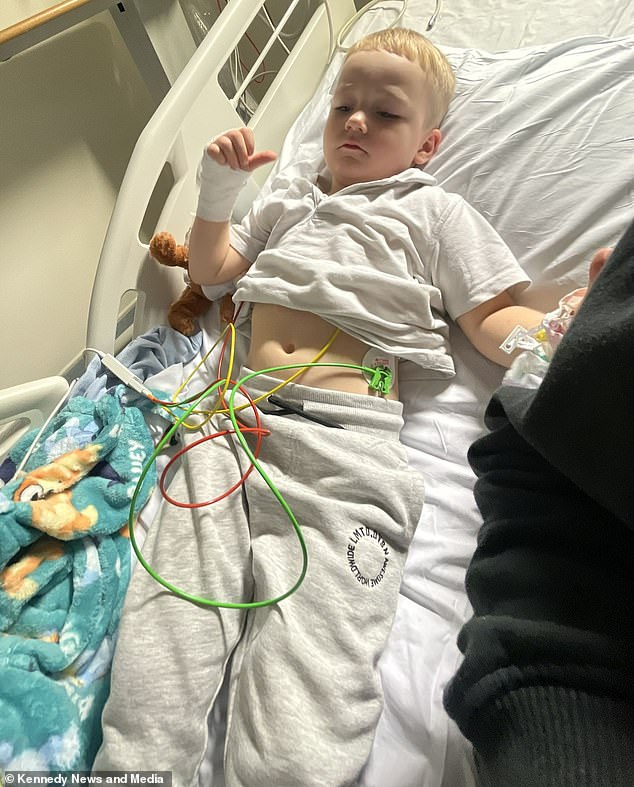Revealed: Why ice-cold slushy drinks could be dangerous for children after TWO babies almost die within a week
They are universally loved by children.
Still, slushy-based iced drinks can be dangerous – so much so that regulators recommend that they should not be sold to children under the age of four.
The safety of the drinks has once again been put in the spotlight following news that two babies, one aged three and the other four, were hospitalized after consuming them.
In both cases, doctors blamed glycerol, an additive lurking in the kid-friendly drinks sold in movie theaters, stores and play parks.
The FSA chiefs based their recommendations on a 350ml drink, similar to those available in shops and cinemas in the UK
Glycerol, or E422, gives the drink the desired slushy effect, prevents the ice-cold drinks from freezing and acts as a sugar-free sweetener.
Although mildly toxic to humans, the amount typically contained in slushies is so small that regular consumption poses little danger to adults and older children.
Their bodies can process it before glycerol levels build up and become a problem, causing poisoning.
However, the same does not apply to younger children.
Due to their much lower body weight, the amount of glycerol required to cause a serious health emergency is much smaller.
Just one 350ml drink with the highest glycerol content could theoretically exceed the ‘safe’ threshold in under 4 seconds.
But health authorities claim the most likely scenario of glycerol intoxication comes from younger children quickly consuming multiple E422-laden drinks.
Mild signs of glycerol intoxication include vomiting and headache.
However, it can send people into shock, where the circulatory system that pumps oxygen-rich blood around the body begins to fail, depriving vital organs of what they need to function.
Signs of shock include having pale, cold, clammy skin, as well as sweating, rapid or shallow breathing, weakness or dizziness, nausea and possibly vomiting, extreme thirst, and yawning and sighing.
Hypoglycemia, or low blood sugar, is another effect of glycerol intoxication.
Symptoms include hunger, dizziness, feelings of anxiety or irritability, sweating, shaking, tingling lips, palpitations, fatigue and weakness, blurred vision and confusion.
In its most severe stages, hypoglycemia can lead to seizures and loss of consciousness.

Beth Green, 24, from Nuneaton, Warwickshire, has revealed her unconscious toddler was admitted to hospital and feared he would die an hour after drinking an ice-cold drink

Beth became increasingly concerned when Albie began ‘hallucinating’ and ‘clawing his face’ – prompting the mother to rush him to hospital
Shock and hypoglycemia can be life-threatening and are considered medical emergencies requiring urgent medical care.
Two recent cases have shown how dangerous glycerol intoxication can be.
Beth Green, 24, from Nuneaton, Warwickshire, four-year-old son was found unresponsive after drinking a strawberry-flavoured slushy during an after-school bowling trip in October last year.
She became increasingly worried after Albie started ‘hallucinating’ and ‘clawing at his face’, prompting her to rush him to hospital.
There, doctors had to start resuscitation because Albie’s blood sugar level had dropped to dangerous levels.
At one point his heart rate became so slow that his parents thought he was going to die.
Doctors later told the couple that if they had not rushed Albie to hospital there, he would have died.
Beth’s story came just days after Scottish mum Victoria Anderson told how her three-year-old son Angus almost died in January after drinking a slushy last month.
The 29-year-old, from Port Glasgow, Inverclyde, had taken her youngest son, three-year-old Angus, and an older sibling shopping on January 4.
Not long after the trio ventured out, Angus asked for a raspberry-flavored slushie after noticing the bright, pink-colored iced drink at a local corner store.
Unaware of the danger, Victoria bought the drink for her son, who had “never had a slushie before.”
About 30 minutes later, while in another store, the three-year-old unexpectedly collapsed and fell unconscious.
Victoria said Angus’ body was limp and “stone cold” when paramedics arrived on the scene and tried to revive him after his blood sugar levels fell dangerously low.
Angus was rushed to Glasgow Children’s Hospital where he remained unconscious for two hours.
Fortunately, both children received the medical care they needed.
The cases come months after British food safety regulators issued guidelines that slush drinks should not be sold to children aged four and under.

A mother has issued an urgent warning about the sale of slushies to children after her toddler son suffered a ‘seizure’ before falling unconscious after sipping the ice-cold drink

Mom Victoria Anderson, 29, with dad Sean Donnelly, 29, and their sons Angus (left), 3, and Archie (right), 5
The Food Safety Agency (FSA) also advised retailers not to give free slushie refills to children under 10.
Slushie manufacturers were also asked to commit to adding only the absolute minimum of glycerol to their products.
In that guidance, published in August, the FSA said it would ‘monitor’ the extent to which the industry followed its advice, leaving the door open for more action in the future.
Most slushies in Britain do not list glycerol levels on their drinks packaging, but the British Soft Drinks Association (BSDA) says all their members have followed the new guidelines.
The FSA advice was based on a slushy with 50,000 mg/l glycerol.
The warning was prompted by two previous cases of glycerol intoxication in Scotland, one in 2021 and 2022.
At the time, the FSA added that mild cases of glycerol intoxication in children, which do not cause such dramatic life-threatening symptoms and instead result in just nausea and headaches, were likely going unreported.
Glycerol is also added to, for example, pre-cooked pasta, rice and breakfast cereals, but in much smaller quantities and is therefore not considered dangerous for children.
